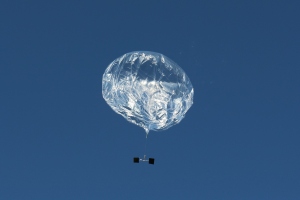 Weather permitting there will be a 434 MHz pico balloon launch from Bristol on Tuesday, February 28 at or after 0830 GMT.
Weather permitting there will be a 434 MHz pico balloon launch from Bristol on Tuesday, February 28 at or after 0830 GMT.
Richard Meadows M0SBU from University of Bristol Students for the Exploration and Development of Space (UBSEDS) writes:
This launch is using a 1.5m envelope and the attempted float altitude will be about 12 km.
The payload is a new tracker design that uses an AX5043 radio. It will be transmitting pips, RSID and Contestia 16/1000 on 434.635 MHz USB, once every two minutes. Callsign “UBSEDS23”.
Between the Contestia transmissions the AX5043 radio will also be used to transmit GMSK at 24 ksymbol/s, centered on 434.637.5 MHz. It’s 4×4 interleaved, R=1/2 convolutional K=5, HDLC framing, whitened etc. as per the AX5043 manual.
This is concatenated with RS(255,223) to mop up some burst errors. IQ recordings of this might be useful so that the data can be extracted once a software decoder exists. Callsign “UBSEDS23G”.
Track the balloon online at https://tracker.habhub.org/#!mt=roadmap&mz=10&qm=All&f=UBSEDS23
UBSEDS http://www.bristol-seds.co.uk/
Useful High Altitude Balloon links https://amsat-uk.org/beginners/balloons/
Richard M0SBU who is involved in the UBSEDS project took the amateur radio training courses run by the Chelmsford Amateur Radio Society (CARS) at Danbury in Essex. Further information on the courses is available from the CARS Training Coordinator, Christopher G0IPU
Tel: 07908-107951
Email: training2017 at g0mwt.org.uk
Web: http://g0mwt.org.uk/training
What is Amateur Radio? http://www.essexham.co.uk/what-is-amateur-radio
Find an amateur radio training course near you https://thersgb.org/services/coursefinder/
![]()